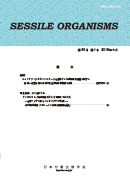
- 2 号 p. 21-
- 1 号 p. 1-
- |<
- <
- 1
- >
- >|
-
Yasunori Sasakura2018 年35 巻2 号 p. 21-29
発行日: 2018/07/30
公開日: 2018/07/31
ジャーナル フリーThe outstanding characteristics of the marine invertebrate chordates, ascidians, are a sessile adult stage and cellulose production. These characteristics are not seen in other chordate groups. Molecular studies have suggested that these two characteristics are tightly linked. Ascidians possess the gene encoding cellulose synthase in their genomes. The disruption of the cellulose synthase gene results in abnormal metamorphosis and failure in adhesion, suggesting that cellulose is necessary for starting and continuing sessile life. Ascidian cellulose synthase is suspected to have been transferred to the tunicate ancestor from a bacterial group by horizontal gene transfer. It was suggested that by this transfer, the ancestor of tunicates was given both the gene body and an epidermal enhancer from the bacterium. The simultaneous transfer of these two genetic elements is thought to have facilitated the success of the gene transfer, which enabled the ancestor to utilize cellulose for evolving sessile ascidians.
抄録全体を表示PDF形式でダウンロード (4326K)
-
塚本 博一2018 年35 巻2 号 p. 30-34
発行日: 2018/10/05
公開日: 2018/10/02
ジャーナル フリーAs there are few reports about the reproductive ecology of Fistulobalanus albicostatus which is a native species of Japan, reproduction of this species was investigated at the Suginoura quay of Miyajima, Hiroshima Prefecture, Seto Inland Sea from October 2013 to October 2014.
Settlement density and aperture length were measured in an 18×18 cm quadrat. And brooding rate (fraction of individuals bearing fertilized eggs) was examined at the tide level below 119 cm from E.H.W.S every month and water temperature and salinity were concurrently measured. As a result, it was estimated that F. albicostatus produced 4,936,000 nauplii per 100 cm2 (15,992,000/18×18) in total from the equation by Iwaki (1981). The value was smaller than that obtained from a population at Matoya Bay, and Machiyaura, in Mie Prefecture by Iwaki (2006). The difference might depend on the difference of the immersed time between the two populations examined.
The larval production is smaller than that of recently introduced striped barnacle Amphibalanus amphitrite, but the population size of F. albicostatus seemed to have remained stable surpassed the alien species over the recent 20 years due to its ability to tolerate euryhaline conditions.
抄録全体を表示PDF形式でダウンロード (519K)
-
梅澤 大樹, 松田 冬彦2018 年35 巻2 号 p. 35-44
発行日: 2018/10/05
公開日: 2018/10/02
ジャーナル フリーRecent progress on synthesis of antifouling natural products and their derivatives are described. Settlement of fouling organisms on ship hulls and fishing nets has serious economic and environmental consequences. In order to prevent problems associated with fouling, organotin compounds (TBT, TBTO, TPT) had been used since the 1960s, until the use of these compounds was prohibited by the International Maritime Organization (IMO) in 2008 due to the considerable harmful effects on various marine organisms. Consequently, the development of environmentally friendly antifouling materials has been pursued. Natural products isolated from marine organisms with antifouling properties have been expected to be candidates for green antifoulants due to their high antifouling ability as well as low toxicity against various marine organisms. Unfortunately, sufficient material cannot be obtained from natural sources, thus impeding further research such as derivatization of compounds or investigation of other biological activities. Total synthesis provides an alternative opportunity to overcome such difficulties because it allows for a greater supply of not only the original compounds but also their derivatives by the modification of the current synthetic method. This review focuses on antifouling natural products and their derivatives that were recently synthesized by the author and other independent groups.
抄録全体を表示PDF形式でダウンロード (1832K)
-
2018 年35 巻2 号 p. 45-57
発行日: 2018/11/30
公開日: 2018/11/28
ジャーナル フリーPDF形式でダウンロード (1244K)
-
2018 年35 巻2 号 p. C21
発行日: 2018/11/30
公開日: 2018/11/28
ジャーナル フリーPDF形式でダウンロード (143K)
- |<
- <
- 1
- >
- >|